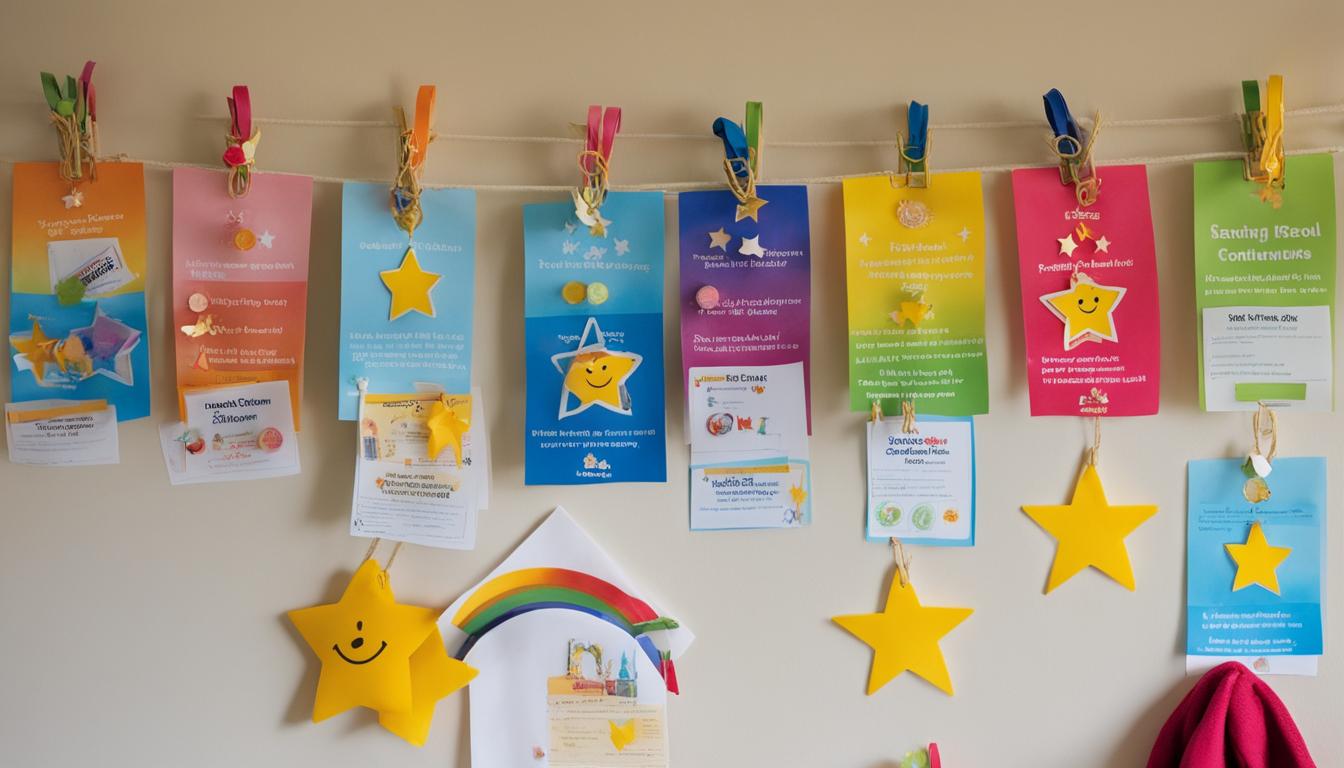Effective Steps on How to Establish Household Rules for Children
As a parent, I’ve learned that creating structure with household rules is essential not only for the orderly running of our home but also for nurturing a positive environment for my children to grow and thrive. Through my journey, I’ve found that how to establish household rules for children isn’t just about laying down what’s right or wrong; it’s about offering a consistent, predictable framework that fosters security and understanding. This strategy has been pivotal in helping my kids know what to expect and how to behave, which aids in their development and prepares them for the world they will navigate.
Setting family rules has also been about balance – choosing which behaviors to guide and when to flexibly adapt. I’m a firm believer that parenting tips for setting rules at home are not one-size-fits-all but should reflect each family’s unique dynamics and values. In my experience, involving my children in the rule-making process has engendered a spirit of cooperation and respect, which in turn has made our home a haven of love and learning.
Skip To The Following Sections
- Understanding the Role of Household Rules in Child Development
- Crafting Clear and Consistent Rules for Your Home
- Strategies for Involving Children in the Rule-Making Process
- Implementing Rules that Nurture Emotional and Physical Safety
- Teaching the Importance of Values and Morals with Household Rules
- Setting Up Routines and Healthy Habits Through Structured Rules
- Adapting Household Rules to Different Ages and Maturity Levels
- Refreshing and Reviewing Family Rules to Ensure Relevance
- FAQ
- How’s creating structure with household rules beneficial for children?
- What are the benefits of consistent household rules?
- How many rules should I start with for my young children?
- Why is it important to involve children in the rule-making process?
- How do household rules nurture emotional and physical safety?
- Can household rules really help teach values and morals?
- What kinds of rules can help encourage personal responsibility in children?
- How should household rules change as children get older?
- How often should we have family meetings to discuss rules?
- Source Links
Key Takeaways
- Establishing clear household rules creates essential structure for children.
- Consistency and predictability in rules accelerate children’s understanding and compliance.
- Balance and adaptability are key to nurturing a positive environment at home.
- Children benefit from participating in the rule-making process.
- Parental adherence to rules sets a powerful example for children.
Understanding the Role of Household Rules in Child Development
The importance of establishing rules for kids in my home has been undeniable. I’ve witnessed firsthand how clear guidelines not only organize day-to-day life but also support my children’s growth and understanding of their surroundings. The significance of this foundation of expected behavior can’t be overstated—it’s like constructing a building where each rule is a crucial block in the architecture of development.
The benefits of consistent household rules extend beyond mere obedience; they instill a sense of security and predictability in a child’s world. I’ve seen the positive effects when my children know what’s expected of them and when they see these expectations being met with consistency. It translates to a more harmonious household and better-behaved kids at school or in other social settings.
Consistent follow through with consequences when rules are broken helps your child have a clear understanding about the importance of rules.
Consistency, however, isn’t limited to parental enforcement. It’s imperative that all family members and caregivers are on the same page when it comes to the rules, preventing mixed messages that would otherwise confuse and undermine a child’s ability to follow them.
- The rule that “no screens are allowed during dinner time” is a strong example. If another caregiver is on their phone at the dinner table, it creates ambiguity.
- Alignment between parents, grandparents, and other caregivers reinforce rules and demonstrate their importance.
To ensure uniformity, the guidelines for setting rules in the household are as important as the rules themselves. I approach this by openly discussing potential rules with all caregivers and by posting the agreed-upon rules within the house for everyone to see.
- We talk openly about what rules my family needs and mutually settle on which ones to assert.
- Having the rules visible to all household members for daily reference aids their integration into our routine.
- We review these rules to accommodate changes in understanding as my children grow and develop.
Through these active steps, the structure we instill at home becomes a valuable life lesson for my children, teaching them not just about discipline but, equally, about the world’s expectations.
Crafting Clear and Consistent Rules for Your Home
In the quest to build a nurturing and structured home environment, I’ve honed in on some effective strategies for creating household rules that resonate with both children and adults alike. It’s about striking that balance between necessary guidance and nurturing independence, making sure the expectations we set can foster the best outcomes for the entire household.

Identifying Key Behaviors to Address with Family Rules
Determining the critical family behaviors that require regulation is an essential starting point. For instance, I found it pivotal to establish a rule around screen time. Limiting screen use during family dinners not only encourages interaction and communication but also instills a sense of togetherness. Similarly, I’ve learned it’s important to be explicit when it comes to furniture usage – no jumping on beds or couches. Rules like these minimize conflict and ensure everyone is clear about what’s expected, reinforcing desired behaviors.
Ensuring Clarity and Simplicity in Rule-Setting
Aiming for clarity in household rules is a strategic move. When I first dove into crafting family rules, I aimed to keep them simple. It’s not about having a long list but rather a concise one that gets to the heart of the household’s daily operations. For my young children, starting with a handful of simple family rules provided a clear foundation that they could easily grasp and remember, creating a consistent home atmosphere for them to thrive in.
As both an architect and enforcer of my home’s environment, I’ve seen that when rules are easily understood and not overly complicated, they become second nature to the household’s routine.
The Significance of Consistent Enforcement of Rules
My relentless focus on maintaining rule consistency has underlined the significance of follow-through. To ensure the consistent rule enforcement that’s crucial for my children’s development, I’ve engaged in open dialogue with other family members and caregivers to establish unified practices. We’ve also kept the rules in plain sight – a visual reminder on the refrigerator – to facilitate clear communication of home guidelines. This visual cue also serves as a subtle reinforcement of expectations, helping to keep everyone accountable.
- Demonstrating by example that everyone, including me, follows the rules to a tee has solidified their importance.
- Emphasizing the need for consistency, especially when there are consequences for breaking a rule, has been key to instilling discipline and respect for the established guidelines.
It is through these consistent household rules that we’ve been able to foster a home environment where each of us – myself and my children – respect and uphold our collective standards, promoting a sense of security and cooperation.
Strategies for Involving Children in the Rule-Making Process
One successful approach that I’ve adopted in my home is involving kids in rule-setting. It’s an engaging strategy that not only helps in creating fair household rules but also ensures that those rules are understood and respected by the little ones. I’ve realized that when children feel their input is valued, they’re more inclined to follow the rules—they’ve helped to create.
Child participation in rules plays a pivotal role in their development. It teaches them negotiation skills, helps them understand the reasoning behind certain boundaries, and fosters a mindset that appreciates structure and cooperation. By incorporating strategies for rule-making with children, our process becomes inclusive, respecting each family member’s ideas and needs.
- Begin with a family discussion, encouraging children to share what they believe are important rules for the household.
- Allow children to present their reasoning for each rule, which fosters critical thinking and validates their contribution.
- Combine everyone’s ideas and negotiate where necessary, finding a middle ground that fulfills both parental expectations and children’s propositions.
- Decide together on the most practical and critical rules that everyone agrees to uphold in the home.
This process not only streamlines rule-setting but also highlights the importance of consequences. Through honest and open conversations, we can decide together on appropriate measures when rules are overlooked or broken, ensuring that children understand and acknowledge the repercussions of their actions.
Through this collaborative approach, rules become a unified contract that the whole family stands behind, rather than a set of orders handed down from on high.
Moreover, I believe it’s critical that rule-making is a dynamic and ongoing conversation in our homes. As our children grow and mature, their abilities and understanding evolve. Therefore, their participation in revising the rules becomes even more significant. This evolution reflects our changing family values and the development of our children’s capabilities.
It’s undeniable that incorporating children in this process might present challenges, and there will certainly be moments of negotiation and compromise. Nonetheless, the empowerment and ownership they experience far outweigh these hurdles, leading to a cooperative and harmonious family life.
- Periodically, revisit the rules to ensure they remain relevant and reflect the evolving capacity of children to understand and adhere to them.
- Documentation is crucial. Writing down the rules after a family consensus means there’s no ambiguity, and they stand as a testament to our collective decision-making process.
- Foster an environment of continuous feedback where children can voice how they feel about the rules, ensuring their perspectives are always considered.
Implementing Rules that Nurture Emotional and Physical Safety
In my dedication to nurturing safety within the walls of our home, I have found that rules for physical safety and emotional well-being rules serve as the foundational blocks. Creating a positive and protective spaces in which my children can grow, explore, and express themselves is a task that requires thoughtful and constructive discipline methods.
Creating a Positive Environment Through Constructive Discipline
To discipline for emotional safety, I have emphasized practices that reinforce empathy and understanding. For instance, implementing a simple rule stating “Use kind words only,” actively promotes a nurturing atmosphere where feelings are respected and emotional wounds are mended with compassion.
Constructive discipline doesn’t just prevent negative behavior—it actively encourages positive interactions and emotional growth.
Acknowledging the six pillars of well-being, including psychological and physical security, has shaped the rulemaking process in our family. We address concerns from “Don’t open the door for strangers” to “Speak up if something hurts you—whether on the inside or outside”, enabling the kids to internalize critical aspects of self-care and interpersonal respect.
- Rules like “No answering the door when home alone” help assure physical safety while teaching responsibility.
- Emphasizing the need to use “respectful language” in our daily interactions ensures that every family member’s dignity is safeguarded.
- Fostering guidelines that reinforce “honest communication” establishes trust as a cornerstone of our family life.
Ultimately, the rules we set are not just directives to be followed; they are lessons in care, empathy, and respect—values that transcend the home and shape the societal landscape my children will navigate.
- By emphasizing rules that engender safety and security, I am equipping my children with the tools to cope and thrive amidst life’s challenges.
- Involving them in creating these guidelines has been instrumental in ensuring the rules are meaningful and adhered to.
- Constantly iterating these safeguards ensures they remain relevant and reflective of our growing dynamics.
The reward of this approach is a robust family fabric where safety—both emotional and physical—is deeply interwoven into our everyday lives, allowing us to focus on flourishing together.
Teaching the Importance of Values and Morals with Household Rules
The concept of instilling values through rules has been integral in the moral development of my children. It’s about setting a framework within which they can discern right from wrong and recognize the importance of integrity and respect. The household thus becomes a stepping stone for them to interact ethically and kindly with the wider world.
Household rules grounded in ethics serve as everyday practice in understanding what it means to be a good person.
Household rules, like many things, are more than just directives; they serve as silent teachers imparting life lessons. A rule such as “apologize when you’re sorry,” for instance, teaches accountability, while “show respect to everyone” instills an understanding of the dignity of each individual. These are not just rules; they are the building blocks of character and essential aspects of my children’s moral development.
For me, consistently modeling these values is as crucial as verbalizing them. If my actions don’t align with the rules I’ve set forth, the mixed messages would dilute the very essence of ethical teaching. In our home, “tell the truth” isn’t just a rule for the children, it’s one that I adhere to as well, so that my behavior exemplifies the core values we hold dear.
I’ve learned that household rules and ethics are inseparable. Rules about politeness, sharing, and listening not only facilitate smoother day-to-day interactions, but also reinforce the underpinning values of respect, generosity, and consideration.
- Implementing rules that encourage empathy, such as “listen when someone is speaking,” teaches my children to value other people’s words and feelings.
- “Treat others as you would like to be treated” is a golden standard in our home, teaching the importance of reciprocity in kindness.
- Even a simple rule like “help out with household chores” underscores the value of responsibility and teamwork.
At its core, my role in establishing these rules isn’t just about enforcing discipline; it’s about guiding my children through their own journey of ethical understanding and nurturing a sense of moral reasoning that will stay with them as they grow and eventually leave our home.
Setting Up Routines and Healthy Habits Through Structured Rules

As I reflect on the significance of structured household guidelines, I am constantly reminded of the power they have in establishing routines for kids. My commitment to this practice has been grounded in the understanding that when children have a clear structure to their day, confusion dissipates and a sense of order prevails. This sense of order is particularly crucial in fostering personal responsibility and developing healthy habits.
Example Rules for Encouraging Personal Responsibility
Setting the stage for personal accountability within the home starts with example rules for kids that promote encouraging responsible behavior. The effectiveness of these rules often hinges on their connection to the daily routines of my children. By embedding responsibilities into the natural flow of their day, I create opportunities for my children to practice autonomy and develop life skills in a supportive environment.
- Routine-based rules such as “Brush your teeth after every meal” help inculcate the importance of personal hygiene and provide a sense of accomplishment.
- With the directive to “Put your dirty clothes in the hamper“, children learn the value of tidy living spaces and begin to take ownership of their belongings.
- Establishing an expectation to “Help set the dinner table” fosters teamwork and the understanding that they contribute to the family unit.
- Rules like “Do your homework before screen time” encourage a balance between work and play, instilling a work ethic that will benefit them in the academic setting and beyond.
These organizing principles are not about micromanaging my children’s every action, but rather about guiding them towards a life of balance and responsibility. The strength of habit is a formidable ally in child development, where the 8 simple actions repeated daily become cornerstones of a reliable routine.
As a parent, my role is to guide my children along the journey of self-improvement—gently nudging them towards greater levels of independence. Employing these structured approaches, I am able to witness the transformation of once-daunting tasks into second nature for my children. In the end, the ultimate reward is seeing them mature into self-reliant individuals who approach the world with confidence and a strong sense of personal agency.
Adapting Household Rules to Different Ages and Maturity Levels
As my children have grown, I’ve realized the importance of adapting household rules to their changing ages and maturity. What was once appropriate for a toddler doesn’t fit the burgeoning independence of a teenager. It’s a delicate balance to create age-appropriate household rules that grow with them, ensuring they are equipped to make good decisions based on their age and level of understanding.
When my kids were younger, simple and clear instructions paved the way for them. However, as they entered their teenage years, I found that adapting rules for teens became necessary. Tweens and teens yearn for more autonomy, and our household guidelines have had to evolve to respect their developmental need for greater freedom and personal responsibility. This often means setting boundaries rather than hard-and-fast rules, and helping them understand the rationale behind each guideline.
By maturity-based home rules, I mean those that align with my children’s cognitive and social progress. For instance, a younger child might have a rule like “Bedtime is at 8 pm,” whereas a teenager might be granted the flexibility to determine his or her own bedtime, as long as it allows for enough sleep to function well the next day.
Evolving Your Approach as Your Children Grow
The challenge lies not just in defining these rules but in evolving them. A static set of mandates won’t do; I recognized the need for a progressive approach to household guidelines that adapts to the phases my children go through.
- For elementary-aged children, clear boundaries and visuals, such as charts, aid their understanding of daily expectations.
- As children transition to adolescence, discussions around the purpose of certain rules enhance their ability to apply good judgment.
- For teenagers, rules focus more on safety and responsibility. We negotiate curfews and responsibilities with an understanding of the reason behind each rule.
Engaging in regular family discussions has become the norm in our household. It ensures that the evolution of our rules is a collaborative process, reflecting a united front that balances parental guidance with children’s growing independence.
Consistency and flexibility are not contradictory when it comes to updating our family’s rules. It’s about maintaining the core values of our household while recognizing the individual needs and maturity of each child.
- Granting independence is done incrementally, acknowledging and rewarding maturity with more privileges and self-governance.
- Introducing chores tailored to their abilities teaches responsibility and accountability, like managing their own laundry by the age of 9.
- Encouraging open dialogue about screen time allows for self-regulation, balancing leisure with productivity.
In conclusion, by cultivating and adapting an evolving set of house rules, I empower my children to grow into responsible, thoughtful adults. The rules of our home are living guidelines, shifting with the growth of each family member, yet always reflecting our core values of respect, responsibility, and care for one another.
Refreshing and Reviewing Family Rules to Ensure Relevance
As time marches on, so do the dynamics within our home, prompting the necessity of reviewing family rules to keep pace. My approach embraces the practice of regularly refreshing household guidelines, ensuring they evolve with my family’s transforming needs and circumstances. It’s about maintaining relevant family rules that resonate with the changing fabric of our lives. Reflection and adjustment are integral, allowing the rules that govern our household interactions to remain pertinent and supportive of our collective growth.
To facilitate this continuous evolution, conducting family meetings for rules has become a foundational activity. These meetings serve as a platform for discussing household rule changes, brainstorming new stipulations, and collectively addressing enforcement challenges. It’s in these gatherings that each of us, as valued members of the family, contributes to the dialogue, ensuring that any adjustments to our home rules are done collaboratively and with unanimous consent. Through these discussions, we refresh our approach to discipline and cooperation, keeping our family’s framework both aligned and agile.
The process of adjusting home rules collaboratively not only reinforces their relevance but also fortifies our bond as a family unit. By keeping the lines of communication open and prioritizing inclusive conversations about our household’s operation, we are committed to stewarding a nurturing and adaptable home environment. It is not just about setting boundaries; it’s a continued investment in the thriving ecosystem that is our family life, where each voice matters in the quest for harmony and mutual respect.
FAQ
How’s creating structure with household rules beneficial for children?
Establishing household rules helps create a sense of structure and security for children, which is critical for their development. It teaches them the importance of boundaries and consistency, and it nurtures a positive environment where they can thrive both emotionally and socially.
What are the benefits of consistent household rules?
Consistent household rules foster predictability in a child’s environment, allowing them to understand and meet expectations more easily. This predictability reduces anxiety and misbehavior, aids in self-regulation, and prepares children for the discipline required in school and community settings.
How many rules should I start with for my young children?
With young children, such as toddlers and preschoolers, it’s best to start with two to three key rules that cover the most important aspects of behavior. This prevents overwhelming them and allows them to remember and follow the rules more effectively.
Why is it important to involve children in the rule-making process?
Including children in creating the rules can increase their sense of ownership and responsibility. It allows them to feel heard and contributes to a more cooperative atmosphere in the home as they understand the purpose and importance of these rules.
How do household rules nurture emotional and physical safety?
Rules that promote emotional and physical safety, like respectful communication and personal boundaries, contribute to creating a secure space where children can express themselves without fear. They also learn behaviors that protect their physical well-being, such as not leaving the house without permission.
Can household rules really help teach values and morals?
Absolutely. By establishing rules around honesty, respect, and accountability, children not only learn about appropriate behaviors but also the underlying moral imperatives that will guide them in their interactions with others throughout life.
What kinds of rules can help encourage personal responsibility in children?
Rules that relate to their daily routines and personal care, such as putting away toys after play, or hygiene tasks like brushing teeth, can encourage children to take responsibility for their own actions and belongings, fostering independence and self-care.
How should household rules change as children get older?
As children grow, their understanding and capabilities evolve, requiring rules to adapt accordingly. For adolescents, rules may focus more on curfews or internet usage, reflecting their expanded social lives and exposure to digital environments.
How often should we have family meetings to discuss rules?
Regular family meetings, perhaps once a month or at a frequency that suits your family’s rhythm, provide a platform to revisit existing rules, suggest modifications, and ensure that the rules stay relevant and reflective of your family’s evolving needs and values.










